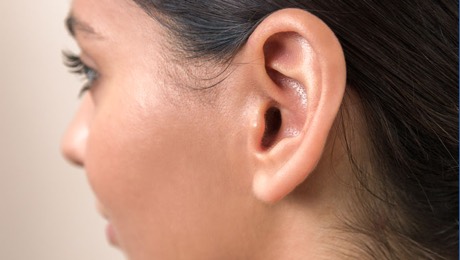


With the advent of digital technology more than 20 years ago, hearing aids have remarkably improved. Today’s hearing instruments are comfortable as well as small and discreet, some models are even completely invisible to others.
Choosing a hearing aid can be a daunting task. Your audiologist will work closely with you to take into account several factors – the type and severity of your hearing loss, your lifestyle, the size and shape of your outer ears and ear canals and your manual dexterity – in order to determine the best hearing device for you.
Explore Hearing Aid Styles
Behind-the-Ear (BTE)

A BTE device is curved to match the contour of the ear and rests directly behind the ear. The housing, which contains all the electronics, is encased in plastic and connects to the ear canal with a clear tube and ear mold. Though more visible than other styles, the BTE is simple to use, making it a popular choice for children. It’s powerful enough for all types of hearing loss.
Receiver-in-the-Canal (RIC)

The RIC hearing aid is a smaller version of the BTE. Similar to a BTE, the device rests behind the ear and includes a thin, transparent wire that connects the housing to the receiver. A soft dome sits at the end of the receiver and is placed inside the ear canal, delivering sound. This style is the most popular today due to its discreet aesthetic and comfort; this style also has the most available for wireless connectivity.
Invisible-in-the-Canal (IIC)

IIC hearing devices are custom-fit and inserted further into the ear canal so they become completely invisible when worn. The devices can be removed and inserted daily by the user. This is not suitable for patients who would have difficulty handling a tiny battery.
Completely-in-the-Canal (CIC)

CIC hearing devices are custom-made to fit deep within the canal and are nearly invisible. It takes advantage of the ear’s natural ability to collect sound. The trade-off, however, is a shorter battery life, and this may, again, prove difficult to adjust for those with poor manual dexterity.
In-the-Canal (ITC)

Slightly larger than the CIC, ITC devices are also custom-made and fill the bottom half of the external ear. Only barely noticeable to those in face-to-face conversation, the ITC uses a slightly larger battery than the CIC style.
In-the-Ear (ITE)

This hearing aid is designed to fill the outer portion of the ear, and is larger than those worn in the ear canals. It is less discreet, but the size allows for more features and makes the unit easier to adjust. A bigger battery translates to longer life and means those with severe or profound hearing loss can benefit from this style.




